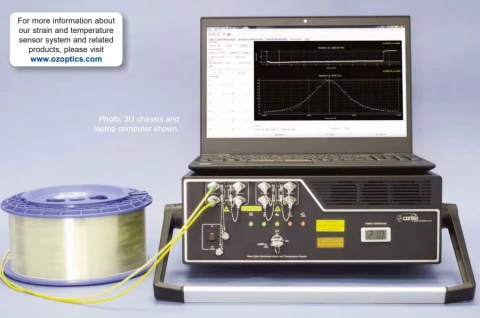Description
The OZ Optics Foresight™ series of fiber optic Distributed Strain and Temperature Sensors (DSTS) BOTDA modules are sophisticated sensor systems that utilize stimulated Brillouin scattering in optical fibers to accurately measure changes in strain and temperature along the length of an optical fiber.
These modules provide real-time, high-resolution measurements, enabling users to detect and address potential issues before failure occurs. The DSTS system offers simultaneous and independent measurement of temperature and strain, allowing for the identification of temperature-induced strain regions.
Fiber Optic Distributed Strain and Temperature Sensors (DSTS): BOTDA Module
Specifications
| Spatial Resolution: | 0.1 m |
|---|---|
| Max Sensing Range: | 100 km |
| Dynamic Range: | 30 dB |
| Temperature Range: | -270 – 1000 deg C |
| Temperature Resolution: | 0.005 deg C |
| Strain Range: | -3 – 4 % |
| Maximum Fiber Length: | 160 km |
| Fault Point Detection: | Acquisition Time: 1 second per thousand scans, Sensing Range (round trip): 100 km |
| Averaging: | 1- 60,000 scans |
| Acquisition Time: | As low as 1 second |
| Strain Accuracy: | ± 2 µε (Whole sensing range for BOTDA) |
| Strain Resolution: | 0.1 µε2 |
| Temperature Accuracy: | ± 0.1°C (Whole sensing range for BOTDA) |
| Strain Range: | -3% (compression) to +4% (elongation) (depending on cable material) |
| Temperature Range: | -270 to +2100 °C |
| Spatial Step: | As low as 5 cm |
| Spatial Accuracy: | As low as 5 cm |
| Sensor Configuration: | Fiber Loop, BOTDA+BOTDR combo unit is optional |
| Number Of Channels: | 251 |
| Spatial Resolution: | 0.5 to 50 m |
Features
- Uses standard telecom single-mode fibers for strain and/or temperature measurement
- Real-time measurement of strain and temperature
- High spatial resolution, strain, and temperature resolution and accuracy
- DLL available for system integrators
- As low as 0.1 m spatial resolution
- Max. 100 km sensing range with max. 160 km fiber length
Applications
- Oil and Gas Pipeline MonitoringPipeline leakage monitoring
- Up to 100 km sensing range per channel
- High spatial resolution supports localized measurement with long sensing range
- Short acquisition/response time
- Structural Health Monitoring (SHM)Sediment monitoring
- Strain and crack monitoring
- Up to 100 km sensing range per channel
- High spatial resolution supports localized measurement with long-range objects
- Oil and Gas Well MonitoringWell integrity management
- Temperature, strain, and pressure monitoring with proper sensing cable and installation
- Not sensitive to hydrogen, which may change the attenuation of the fiber
- Refinery Efficiency SensingImprove the efficiency of the refinery per distributed temperature profile
- Reduce downtime while ensuring safety levels
- Uses low-cost telecom single-mode fiber cable
- Dam MonitoringDam internal temperature monitoring
- Crack/sediment/deformation/seepage monitoring
- Up to 100 km sensing range per channel
- Civil Engineering applications continued...
Frequently Asked Questions
What is the OZ Optics Foresight™ series of fiber optic Distributed Strain and Temperature Sensors (DSTS) BOTDA module used for?
The DSTS system is used to measure changes in both strain and temperature along the length of an optical fiber, enabling users to detect and address potential issues before failure occurs.
Can the DSTS system measure temperature and strain simultaneously and independently?
Yes, the DSTS system can measure temperature and strain simultaneously and independently, allowing for the identification of temperature-induced strain regions.
What is the sensing range of the DSTS system?
The DSTS system offers a maximum sensing range of 100 km per channel with a maximum fiber length of 160 km.
Is the DSTS system sensitive to hydrogen?
No, the DSTS system is not sensitive to hydrogen, which may change the attenuation of the fiber.
What type of fibers are used for strain and/or temperature measurement?
Standard telecom single-mode fibers are used for strain and/or temperature measurement.
Similar Products
Thank You!
Your inquiry has been received.
Create an account by adding a password
Why create an account?
- Auto-complete inquiry forms
- View and manage all your past messages
- Save products to your favorites
- Close your account anytime — no hassle



